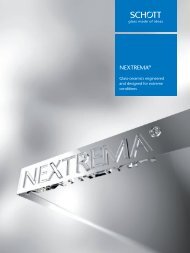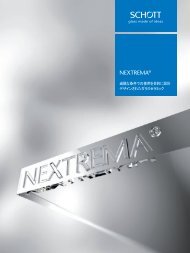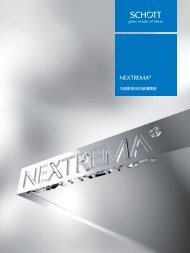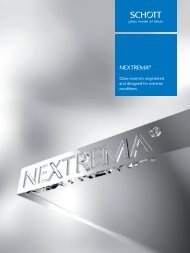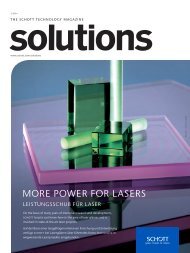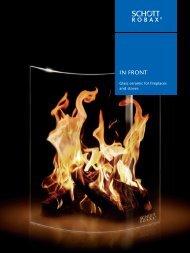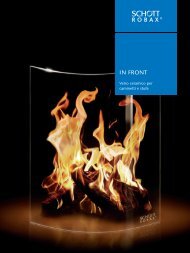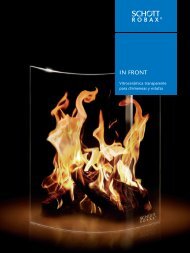SCHOTT Technical Glasses
Apart from its application in optics, glass as a technical material has exerted a formative influence on the development of important technological fields such as chemistry, pharmaceutics, automotive, optics, optoelectronics and information technology. SCHOTT Technical Glasses offers pertinent information in concise form. It contains general information for the determination and evaluation of important glass properties and also informs about specific chemical and physical characteristics and possible applications of the commercial technical glasses produced by SCHOTT. With this brochure, we hope to assist scientists, engineers, and designers in making the appropriate choice and make optimum use of SCHOTT products.
Apart from its application in optics, glass as a technical material has exerted a formative influence on the development of important technological fields such as chemistry, pharmaceutics, automotive, optics, optoelectronics and information technology. SCHOTT Technical Glasses offers pertinent information in concise form. It contains general information for the determination and evaluation of important glass properties and also informs about specific chemical and physical characteristics and possible applications of the commercial technical glasses produced by SCHOTT. With this brochure, we hope to assist scientists, engineers, and designers in making the appropriate choice and make optimum use of SCHOTT products.
Create successful ePaper yourself
Turn your PDF publications into a flip-book with our unique Google optimized e-Paper software.
15<br />
in the glass after 15 min of annealing time. On the other<br />
hand, the dimensional stability of the glass is sufficient for<br />
many purposes, and its brittleness (susceptibility to cracking)<br />
is almost fully developed. The glass is now in the transformation<br />
range, and many properties indicate this by changing<br />
the direction of their temperature dependence. Thus the<br />
change in the slope of the coefficient of linear expansion<br />
is used to define the transformation range by way of the<br />
so-called transformation temperature T g according to<br />
ISO 7884-8.<br />
already takes 3 – 5 hours. Therefore faster cooling is possible<br />
at temperatures below the strain point without freezing in<br />
new stresses. On the other hand, the strain point marks the<br />
maximum value for short-term heat load. Thermally prestressed<br />
glasses, in contrast, show significant stress relaxation<br />
already at 200 – 300 K below T g . For glasses with precisely<br />
defined dimensions (e.g. etalons or gauge blocks)<br />
and in case of extreme demands on the stability of certain<br />
glass properties, application temperatures of 100 – 200 °C<br />
can already be the upper limit.<br />
3<br />
At this transformation temperature, most glasses show viscosities<br />
in the range of 10 12 – 10 13.5 dPa · s. The “10 13 temperature,”<br />
at which the glass has a viscosity of 10 13 dPa · s<br />
(method of measurement: ISO 7884-4), is called the annealing<br />
point. It is of crucial importance for stress relaxation<br />
after the hot forming of glasses, indicating the upper<br />
temperature limit of the so-called annealing range, at which<br />
internal stress is released within minutes. The lower limit of<br />
the annealing range is expressed by the strain point, at<br />
which the glass has a viscosity of 10 14.5 dPa · s (determination:<br />
extrapolation from the viscosity-temperature curve).<br />
For most glasses, the strain point lies about 30 – 40 K below<br />
the annealing point. Relaxation of internal stresses here<br />
14<br />
12<br />
10<br />
6<br />
5<br />
4<br />
3<br />
2<br />
1<br />
3.2 Strength<br />
The high structural (= theoretical) strength of glasses and<br />
glass-ceramics (> 10 4 MPa) cannot be used in practice since<br />
the strength of glass articles is actually determined by surface<br />
defects induced by wear. Contact with hard materials<br />
often causes damages in the surfaces of glass and glass-ceramic<br />
articles in the form of tiny chips and cracks, at whose<br />
tips critical stress concentrations may be induced by mechanical<br />
load, causing breakage of the articles.<br />
In ductile materials such as metals, these stress concentrations<br />
are relieved by plastic flow. <strong>Glasses</strong> and glass-ceramics,<br />
in contrast, behave as brittle as ceramics. At typical application-specific<br />
temperatures and load times, they show no<br />
plastic flow by which the stress concentrations at the chip<br />
and crack tips could be relieved.<br />
Regarding strength, surface damages are therefore particularly<br />
important for glass and glass-ceramic articles.<br />
lg η in dPa ·s ––><br />
8<br />
7<br />
6<br />
8<br />
4<br />
2<br />
0<br />
200 400 600 800 1000 1200 1400 1600<br />
Temperature in °C ––><br />
Surface Condition<br />
As a result of wear-induced surface defects, glass and glassceramic<br />
articles have practical tensile strengths of 20 – 200<br />
MPa, depending on the surface condition (Figure 7) and<br />
exposure conditions. Only a slight – as a rule negligible –<br />
dependence on the chemical composition is found for silicate<br />
glasses.<br />
Fig. 6. Viscosity-temperature curves for some important technical glasses.<br />
1: fused silica, 2: 8253, 3: 8252, 4: 8330, 5: 8350, 6: 8248, 7: 8095,<br />
8: 8465. <strong>Glasses</strong> with steep gradients (8) are called “short” glasses and<br />
those with relatively shallow gradients (6) are “long” glasses






